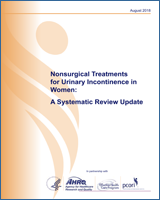From: Results

NCBI Bookshelf. A service of the National Library of Medicine, National Institutes of Health.
| Intervention A | Intervention B | Bother | Daily Activities | Distress | General Health | Mental Health | Pain | Sexual Health | Sleep/Energy | |
|---|---|---|---|---|---|---|---|---|---|---|
| Behavioral vs. Placebo | Acupuncture | Sham | 1 (20): 1 NS | |||||||
| Bladder support | Sham | 1 (46): 1 favor† A | 1 (46): 1 NS | 1 (46): 1 favor A | 1 (46): 1 NS | |||||
| Bladder training, PFMT | Sham | 1 (108): 1 NS | ||||||||
| Education, bladder training, PFMT | Sham | 1 (103): 1 NS | 4 (443): 2 favor A 2 NS | 1 (45): 1 NS | 1 (45): 1 NS | 2 (148): 2 NS | 1 (45): 1 NS | |||
| Education, weight loss | Sham | 1 (48): 1 favor A | 1 (48): 1 favor A | 1 (48): 1 favor A | 1 (48): 1 favor A | |||||
| Electroacupuncture | Sham | 2 (102): 1 favor A 1 disc | ||||||||
| PFMT | Sham | 6 (379): 4 favor A 2 NS | 7 (513): 2 disc 5 NS | 1 (247): 1 favor A | 4 (327): 2 disc 2 NS | 2 (85): 1 favor A 1 NS | 2 (160): 1 disc 1 NS | |||
| PFMT, biofeedback | Sham | 1 (31): 1 favor A | 1 (32): 1 disc | |||||||
| PFMT, weights | Sham | 1 (41): 1 disc | 1 (57): 1 favor A | |||||||
| Yoga | Sham | 1 (18): 1 NS | 1 (18): 1 favor A | |||||||
| Neuromodulation vs. Placebo | Magnetic simulation | Sham | 4 (204): 2 favor A 2 disc | 2 (121): 2 NS | 1 (34): 1 favor A | 1 (20): 1 NS | 1 (20): 1 NS | 1 (20): 1 NS | ||
| TENS | Sham | 1 (161): 1 favor A | 1 (27): 1 NS | 1 (27): 1 NS | 3 (208): 1 favor A 2 disc | 2 (222): 2 favor A | ||||
| Behavioral + Neuromodulation vs. Placebo | TENS, PFMT | Sham | 1 (60): 1 disc | 2 (122): 2 disc | ||||||
| TENS, PFMT, biofeedback | Sham | 1 (30): 1 favor A | ||||||||
| Other vs. Placebo | Intravesical pressure release device | Sham | 1 (115): 1 NS |
Empty cells indicate that the intervention was not evaluated for the outcome designated in the given column
Abbreviations: disc = discordant findings; NS = non-significant; PFMT = pelvic floor muscle training; TENS = transcutaneous electrical nerve stimulation.
Results are given as number of studies (number of people), number of studies with significant difference and which intervention it favors, number of studies with discordant results (that is, within the same study, significant differences favoring one intervention were found on one scale or subscale, but nonsignificant differences were found on others, number of studies with nonsignificant differences.
Favor indicates a statistically significant (net) difference favoring the specified intervention.
From: Results

NCBI Bookshelf. A service of the National Library of Medicine, National Institutes of Health.